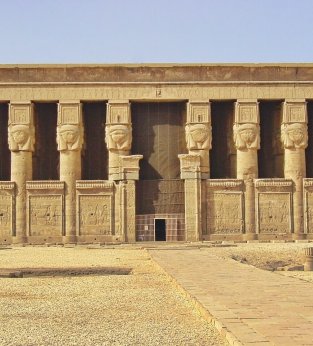Stay updated!
The temple of Isis on Philae was the last stronghold of the pagan faith in Egypt and was only closed in the 6th century AD. Today, thanks to its beautiful location, this former cult center is attracting crowds again. We will be able to visit it during our 10-day tour of Egypt or 8-days Egypt tour.
The most beautiful view of the temple of Isis is from a boat on the Nile. From the distance, you can see the buildings and pylons shimmering in the sun. The closer you get to the temple, the more detail you can see; fragments of high perimeter walls, colonnades and, plant capitals of the column from the hypostyle hall. Lush green palms and shrubs grow all around.
The Temple of Isis exists thanks to the hard work of specialists working on its transfer from Philae Island. The construction of the first Aswan dam meant that Philae Island was periodically flooded by the waters of the Nile. The construction of the High Dam of Aswan made it necessary to immediately move the temple to a higher place, which turned out to be the nearby island of Agilkia. Despite the new location, in the minds of scientists and tourists, the sanctuary of Isis still functions under the name of the temple of Philae.
The temple complex was expanded from the 8th century BC to the first centuries of the first millennium. The main cult site is the temple of Isis, the goddess of magic and related medicine.
According to mythology, it was here that the goddess Isis found the heart of her brother and husband, Osiris, murdered by Set, the lord of war and chaos. Set dismembered Osiris's body and scattered it across the country. Isis found all parts of the body (except for the falus), tied it together with bandages and, organized a funeral. Captured by the determination of Isis, the gods resurrected Osiris, making him ruler of the underworld.
The entrance to the temple is preceded by a pylon and two colonnades that run from south to north. Each of the columns has a different plant capital. From the entrance you enter a spacious courtyard. It is surrounded by a colonnade from the east, and the Birth House from the west. Every year it was celebrated with the birth of the local divine triad. When you look towards the north end of the courtyard, you can see the facade of the Temple of Isis.
Through a small columned room, you enter the three-nave sanctuary where the statue of Isis once stood. The reliefs on the interior walls show the birth of the pharaoh Ptolemy VI Philometor (one of the builders of the complex), as well as scenes from the myth of the resurrection of Osiris.
We explore this architectural feat on our Egypt tours. Join us, book your luxury Egypt tour!

















